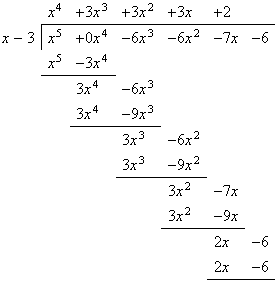Solving higher-degree polynomial equations
A quick-and-dirty approach that works a lot of the time
Theory review (that your H.S. should have taught you):
Definition: For a polynomial p(x), we say c is a
root if (and only if) p(c) = 0.
The Root/Factor Theorem: Given a polynomial p(x), c
is a root if and only if x-c is a factor.
Consequently, an easy way to find all the roots of a polynomial
(including repeated roots, and their multiplicity, i.e. the
number of times they are repeated) is:
Find a root c somehow (including guessing). Test
that it's a root by evaluating p(c).
If it is a root, divide out
the corresponding factor x-c.
Lather, rinse, repeat until all the roots/factors are found.
Practical matters
So the two difficult parts remaining in finding all the roots of any
polynomial are:
- How do I find/guess roots, and
- How do I divide out factors of the form x-c?
Answers:
1) How do I find/guess roots (of polynomials)?
Method a: Try graphing the polynomial and looking for easily
recognized x-intercepts (integer roots aren't too hard to
guess).
A useful fact: The graph of p(x) has a horizontal
tangent where it touches the x-axis if and only if there is a
multiple root there.
Except for diabolically cruel polynomials, this method usually allows
one to divide out enough factors to beat the thing down to a quadratic
(for which one can easily find the remaining roots).
Method b:
The Rational Roots Theorem:
If the polynomial p(x)
= anxn+an-1xn-1+an-2xn-2+...+a2x2+a1x+a0
has integer coefficients,
and r/s is a rational root of p(x)
written in lowest terms,
then r must be a factor of a0
and s must be a factor of an.
So to find all the rational roots of p(x), write every
possible combination of (factor of a0)/(factor
of an) and try them all.
Note this will not find irrational roots such as 2+ 3, much less complex roots such as
3+4i.
3, much less complex roots such as
3+4i.
2) How do I divide out factors of the form x-c?
Method a: Use polynomial long division. For example, to divide

(note the inclusion of the fourth degree term in the second copy), we
do the familiar algorithm:
 .
.
Notes: We pick each term on the top so that when we multiply by the
divisor (x-3 on the left), we will get the highest power term
remaining under the division bar.
We subtract to find what's left under the division bar.
We're lazy in not copying down all the terms from the subtraction, we copy only the ones we need
for the moment.
If we've chosen an actual factor (i.e. x-3), then the remainder
at the very end is zero (a very good thing).
The example above shows that x5-6x3-6x2-7x-6
factors as (x-3)(x4+3x3+3x2+3x+2).
Method b: Use synthetic division (much tidier). To work out x5-6x3-6x2-7x-6
divided by x-3, write out the coefficients of x5-6x3-6x2-7x-6
in a row inside the boxy thing (see example below) and put the root (3)
that corresponds to the factor x-3 on the left (note the sign
change from "x minus 3" to "3"):

Note the 0 added in the boxy thing for the missing 4th power term -
THIS IS VERY IMPORTANT. Now, starting at the leftmost coefficient in
the box, add vertically and multiply by 3 (our proposed root) moving
diagonally up and right:

Above we see the one added vertically (1 plus an empty space) to give 1
below the boxy thing, then 1 (below the box) times 3 (our proposed root) going
up and to the right. Now, lather, rinse, repeat: Add vertically,
then multiply the result by the root to get the next number upward and
rightward:

and again:

and again:

and again:

and the final vertical addition gives:

We like that zero, it's our remainder - which tells us that our
proposed root 3 is an actual root of the polynomial. Now read
off the numbers underneath the box (excluding the zero remainder) -
they are the coefficients of the quotient: x4+3x3+3x2+3x+2
So the above shows that x5-6x3-6x2-7x-6
factors as (x-3)(x4+3x3+3x2+3x+2).
Last Modified November 9, 2007.
Prof.
Janeba's Home Page | Send comments or questions to: mjaneba willamette.edu
willamette.edu
Department
of Mathematics | Willamette
University Home Page
 .
.






 willamette.edu
willamette.edu